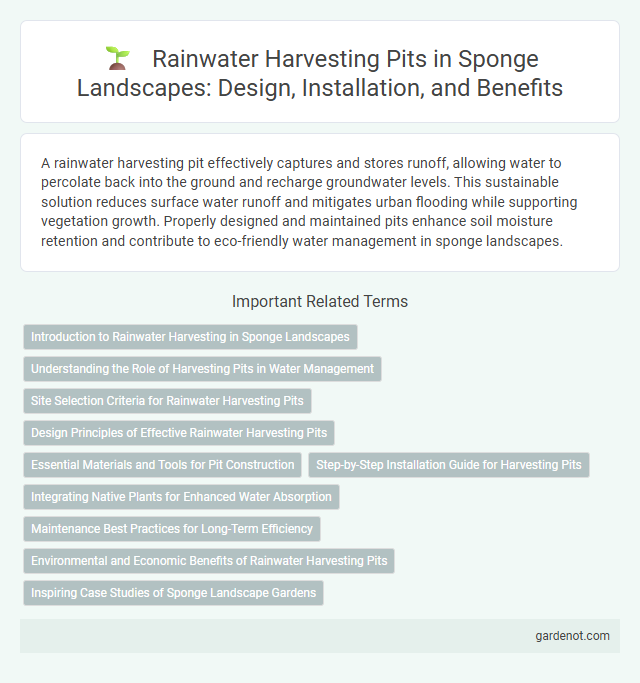A rainwater harvesting pit effectively captures and stores runoff, allowing water to percolate back into the ground and recharge groundwater levels. This sustainable solution reduces surface water runoff and mitigates urban flooding while supporting vegetation growth. Properly designed and maintained pits enhance soil moisture retention and contribute to eco-friendly water management in sponge landscapes.
Introduction to Rainwater Harvesting in Sponge Landscapes
Rainwater harvesting pits in sponge landscapes capture and store rainfall to enhance groundwater recharge and reduce surface runoff. These pits promote water infiltration in urban and rural areas, mitigating flood risks while supporting vegetation growth. Strategically placed rainwater harvesting systems optimize water retention and improve ecosystem resilience in sponge cities.
Understanding the Role of Harvesting Pits in Water Management
Rainwater harvesting pits play a crucial role in sponge landscape design by capturing and storing runoff to enhance groundwater recharge and reduce surface water flooding. These pits filter pollutants and sediments, improving water quality while promoting sustainable water management practices. Strategically placed harvesting pits optimize infiltration rates, supporting urban resilience against drought and heavy rainfall events.
Site Selection Criteria for Rainwater Harvesting Pits
Site selection criteria for rainwater harvesting pits in sponge landscape design prioritize locations with sufficient catchment area and permeable soil to maximize infiltration and storage capacity. Sites should avoid areas with high contamination risk or structural instability to ensure water quality and pit longevity. Proximity to vegetation and slope gradient are evaluated to enhance runoff capture while preventing erosion and sedimentation within the pit.
Design Principles of Effective Rainwater Harvesting Pits
Effective rainwater harvesting pits incorporate key design principles such as optimal size and depth to maximize water infiltration and storage capacity. The pit must be lined with permeable materials to facilitate slow seepage while preventing erosion and structural collapse. Strategic placement in low-lying areas ensures efficient rainwater capture, promoting groundwater recharge and reducing surface runoff.
Essential Materials and Tools for Pit Construction
Constructing an effective rainwater harvesting pit requires essential materials such as perforated pipes for drainage, gravel, sand, and geotextile fabric to ensure proper filtration and prevent soil clogging. Tools including a spade, pickaxe, measuring tape, and tamper are necessary for precise excavation and compacting the soil around the pit. Using quality materials and appropriate tools enhances the pit's durability and efficiency in capturing and storing rainwater.
Step-by-Step Installation Guide for Harvesting Pits
Excavating a rainwater harvesting pit begins by selecting a suitable location with good runoff collection potential, followed by digging the pit to recommended dimensions, typically 1.5 to 3 meters deep and 1 to 2 meters wide. The next step involves lining the pit with permeable materials such as gravel or sand to enhance infiltration while preventing soil erosion, then installing a filtration system using gravel layers or geotextile fabric to exclude debris. Finally, connecting the pit to gutter downspouts or surface runoff channels ensures efficient water flow into the system, and covering the pit with a mesh prevents mosquito breeding and contamination.
Integrating Native Plants for Enhanced Water Absorption
Rainwater harvesting pits integrated with native plants significantly improve water absorption by leveraging deep root systems that increase soil permeability and reduce runoff. Native vegetation enhances the pit's ability to retain and slow water infiltration, promoting natural groundwater recharge and minimizing erosion. Selecting drought-tolerant indigenous species ensures sustainable moisture retention while supporting local biodiversity within the sponge landscape framework.
Maintenance Best Practices for Long-Term Efficiency
Regular inspection and cleaning of rainwater harvesting pits prevent sediment buildup and blockages, ensuring optimal water infiltration and storage. Remove debris and organic matter from the catchment area and pit to maintain permeability and enhance groundwater recharge. Implement periodic desilting, check structural integrity, and repair cracks to sustain long-term efficiency and functionality of the sponge landscape system.
Environmental and Economic Benefits of Rainwater Harvesting Pits
Rainwater harvesting pits significantly reduce surface runoff, enhancing groundwater recharge and mitigating urban flooding, which supports sustainable water management and ecosystem balance. These pits lower water bills by providing an alternative water source for irrigation and non-potable uses, reducing dependency on municipal supply and conserving water resources. Economies benefit through decreased infrastructure costs related to stormwater management and increased resilience against drought conditions.
Inspiring Case Studies of Sponge Landscape Gardens
Rainwater harvesting pits in sponge landscape gardens demonstrate effective water management by capturing and storing runoff, reducing urban flooding and improving groundwater recharge. In Bengaluru, India, community-driven sponge gardens with rainwater pits have restored local water tables and enhanced urban greenery, serving as replicable models for water-scarce cities. These inspiring case studies highlight the integration of natural hydrological processes and urban design to promote sustainability and resilience in landscape architecture.
Rainwater harvesting pit Infographic

 gardenot.com
gardenot.com